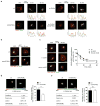Coordinated regulation of bidirectional COPI transport at the Golgi by CDC42
- PMID: 25945738
- PMCID: PMC4449304
- DOI: 10.1038/nature14457
Coordinated regulation of bidirectional COPI transport at the Golgi by CDC42
Abstract
The Golgi complex has a central role in the intracellular sorting of secretory proteins. Anterograde transport through the Golgi has been explained by the movement of Golgi cisternae, known as cisternal maturation. Because this explanation is now appreciated to be incomplete, interest has developed in understanding tubules that connect the Golgi cisternae. Here we show that the coat protein I (COPI) complex sorts anterograde cargoes into these tubules in human cells. Moreover, the small GTPase CDC42 regulates bidirectional Golgi transport by targeting the dual functions of COPI in cargo sorting and carrier formation. CDC42 also directly imparts membrane curvature to promote COPI tubule formation. Our findings further reveal that COPI tubular transport complements cisternal maturation in explaining how anterograde Golgi transport is achieved, and that bidirectional COPI transport is modulated by environmental cues through CDC42.
Conflict of interest statement
The authors declare no competing financial interests.
Figures














Comment in
-
Cell biology: Polarized transport in the Golgi apparatus.Nature. 2015 May 28;521(7553):427-8. doi: 10.1038/nature14521. Epub 2015 May 6. Nature. 2015. PMID: 25945742 No abstract available.
References
-
- Nakano A, Luini A. Passage through the Golgi. Curr Opin Cell Biol. 2010;22:471–478. - PubMed
-
- Bonfanti L, et al. Procollagen traverses the Golgi stack without leaving the lumen of cisternae: evidence for cisternal maturation. Cell. 1998;95:993–1003. - PubMed
-
- Losev E, et al. Golgi maturation visualized in living yeast. Nature. 2006;441:1002–1006. - PubMed
-
- Matsuura-Tokita K, Takeuchi M, Ichihara A, Mikuriya K, Nakano A. Live imaging of yeast Golgi cisternal maturation. Nature. 2006;441:1007–1010. - PubMed
Publication types
MeSH terms
Substances
Grants and funding
LinkOut - more resources
Full Text Sources
Other Literature Sources
Research Materials
Miscellaneous

